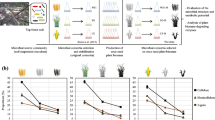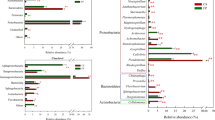Abstract
Enrichment of microbial consortia provides an approach to simulate and investigate microbial communities in natural environments. In this study, a cellulolytic microbial consortium SQD-1.1 was enriched from mangrove soil of Qinglan port (Hainan, China) by 27 times continuous subcultivation under anaerobic static conditions. The consortium could completely degrade 0.2 % (w/v) filter paper within 3 days and utilized it as the sole carbon source. PCR-denaturing gradient gel electrophoresis analysis revealed a stable microbial community structure in the incubation process of 10 days and in the procedure of subcultivation. Twenty-four operational taxonomic units belonging to seven phyla were obtained from the full-length 16S rRNA gene library. Five clones, closest related to the genera Alkaliflexus, Clostridium, Alistipes, Spirochaeta, and Trichococcus, were the predominant ones. Among them, M117, phylogeneticly showing high similarity (16S rRNA gene identity, 95.3 %) with the cellulolytic anaerobic bacterium Clostridium straminisolvens CSK1T, was the potential key cellulolytic bacterium. Using the plate cultivation method, 12 strains, including one potential new species and four potential new species of new genera, were isolated. The strain P2, corresponding to the most frequently detected clone (M05) in the 16S rRNA gene library, showed both CMCase and xylanase activity and may be another important cellulolytic bacterium. The findings of cellulase activity in cell pellet and cohesion and dockerin domains in metagenome data further suggested the potential of utilization of cellulosomes by the consortium to degrade cellulose. Consortium SQD-1.1 provides a candidate for investigating the mechanism of cellulose degradation under anoxic conditions in natural environments.




Similar content being viewed by others
References
Bomar L, Maltz M, Colston S, Graf J (2011) Directed culturing of microorganisms using metatranscriptomics. MBio 2:e00012-11
Cock PJA, Fields CJ, Goto N, Heuer ML, Rice PM (2010) The Sanger FASTQ file format for sequences with quality scores, and the Solexa/Illumina FASTQ variants. Nucleic Acids Res 38:1767–1771
Doi RH, Kosugi A (2004) Cellulosomes: plant-cell-wall-degrading enzyme complexes. Nat Rev Microbiol 2:541–551
Faaij APC (2006) Bio-energy in Europe: changing technology choices. Energy Pol 34:322–342
Feng Y, Yu Y, Wang X, Qu Y, Li D, He W, Kim BH (2011) Degradation of raw corn stover powder (RCSP) by an enriched microbial consortium and its community structure. Bioresour Technol 102:742–747
Finn RD, Clements J, Eddy SR (2011) HMMER web server: interactive sequence similarity searching. Nucleic Acids Res 39:W29–W37
Fontes CM, Gilbert HJ (2010) Cellulosomes: highly efficient nanomachines designed to deconstruct plant cell wall complex carbohydrates. Annu Rev Biochem 79:655–681
Gao Z, Ruan L, Chen X, Zhang Y, Xu X (2010) A novel salt-tolerant endo-β-1,4-glucanase Cel5A in Vibrio sp. G21 isolated from mangrove soil. Appl Microbiol Biotechnol 87:1373–1382
Guevara C, Zambrano MM (2006) Sugarcane cellulose utilization by a defined microbial consortium. FEMS Microbiol Lett 255:52–58
Haruta S, Cui Z, Huang Z, Li M, Ishii M, Igarashi Y (2002) Construction of a stable microbial community with high cellulose-degradation ability. Appl Microbiol Biotechnol 59:529–534
Hess M, Sczyrba A, Egan R, Kim TW, Chokhawala H, Schroth G, Luo S, Clark DS, Chen F, Zhang T, Mackie RI, Pennacchio LA, Tringe SG, Visel A, Woyke T, Wang Z, Rubin EM (2011) Metagenomic discovery of biomass-degrading genes and genomes from cow rumen. Science 331:463–467
Hong K, Yan B (2008) Uncultured microorganisms in Hainan mangrove soil: diversity and functional genes. In: Liu SJ, Drake HL (eds) Microbes and the environment, perspective and challenges. Science Press, Beijing, China, pp 52–58
Hyde KD, Lee SY (1995) Ecology of mangrove fungi and their role in nutrient cycling: what gaps occur in our knowledge? Hydrobiologia 295:107–118
Jiang YX, Zheng TL, Tian Y (2006) Research on mangrove soil microorganisms: past, present and future. Wei Sheng Wu Xue Bao 46:848–851
Kaeberlein T, Lewis K, Epstein SS (2002) Isolating “uncultivable” microorganisms in pure culture in a simulated natural environment. Science 296:1127–1129
Kato S, Haruta S, Cui ZJ, Ishii M, Yokota A, Igarashi Y (2004) Clostridium straminisolvens sp. nov., a moderately thermophilic, aerotolerant and cellulolytic bacterium isolated from a cellulose-degrading bacterial community. Int J Syst Evol Microbiol 54:2043–2207
Kato S, Haruta S, Cui ZJ, Ishii M, Igarashi Y (2005) Stable coexistence of five bacterial strains as a cellulose-degrading community. Appl Environ Microbiol 71:7099–7106
Kevin EA, Nadia AC, John CF, Antonia JJ, Andrew JW (2005) At least one in twenty 16S rRNA sequence records currently held in public repositories estimated to contain substantial anomalies. Appl Environ Microbiol 71:7724–7736
Kevin EA, Nadia AC, John CF, Antonia JJ, Andrew JW (2006) New screening software shows that most recent large 16S rRNA gene clone libraries contain chimeras. Appl Environ Microbiol 72:5734–5741
Kim OS, Cho YJ, Lee K, Yoon SH, Kim M, Na H, Park SC, Jeon YS, Lee JH, Yi H, Won S, Chun J (2012) Introducing EzTaxon-e: a prokaryotic 16S rRNA gene sequence database with phylotypes that represent uncultured species. Int J Syst Evol Microbiol 62:716–721
Kimura M (1980) A simple method for estimating evolutionary rates of base substitutions through comparative studies of nucleotide sequences. J Mol Evol 16:111–120
Leschine SB, Canale-Parola E (1983) Mesophilic cellulolytic clostridia from fresh water environments. Appl Environ Microbiol 46:728–737
Lv Z, Yang J, Wang E, Yuan H (2008) Characterization of extracellular and substrate-bound cellulases from a mesophilic sugarcane bagasse-degrading microbial community. Proc Biochem 43:1467–1472
Lynd LR, Weimer PJ, van Zyl WH, Pretorius IS (2002) Microbial cellulose utilization: fundamentals and biotechnology. Microbiol Mol Biol Rev 66:506–577
Mach RL, Zeilinger S (2003) Regulation of gene expression in industrial fungi: Trichoderma. Appl Microbiol Biotechnol 60:515–522
McKew BA, Coulon F, Osborn AM, Timmis KN, McGenity TJ (2007) Determining the identity and roles of oil-metabolizing marine bacteria from the Thames estuary, UK. Environ Microbiol 9:165–176
Miller GL (1959) Use of dinitrosalicylic acid reagent for determination of reducing sugars. Anal Chem 31:426–428
Muyzer G, de Waal EC, Uitterlinden AG (1993) Profiling of complex microbial populations by denaturing gradient gel electrophoresis analysis of polymerase chain reaction-amplified genes coding for 16S rRNA. Appl Environ Microbiol 59:695–700
Okeke BC, Lu J (2011) Characterization of a defined cellulolytic and xylanolytic bacterial consortium for bioprocessing of cellulose and hemicelluloses. Appl Biochem Biotechnol 163:869–881
Percival Zhang YH, Himmel ME, Mielenz JR (2006) Outlook for cellulase improvement: screening and selection strategies. Biotechnol Adv 24:452–481
Pointing SB, Buswell JA, Jones EBG, Vrijmoed LLP (1999) Extracellular cellulolytic enzyme profiles of five lignicolous mangrove fungi. Myc Res 103:696–700
Punta M, Coggill PC, Eberhardt RY, Mistry J, Tate J, Boursnell C, Pang N, Forslund K, Ceric G, Clements J, Heger A, Holm L, Sonnhammer EL, Eddy SR, Bateman A, Finn RD (2012) The Pfam protein families database. Nucleic Acids Res 40:290–301
Saitou N, Nei M (1987) The neighbor-joining method: a new method for reconstructing phylogenetic trees. Mol Biol Evol 4:406–425
Sizova MV, Hohmann T, Hazen A, Paster BJ, Halem SR, Murphy CM, Panikov NS, Epstein SS (2012) New approaches for isolation of previously uncultivated oral bacteria. Appl Environ Microbiol 78:194–203
Syn CK, Swarup S (2000) A scalable protocol for the isolation of large-sized genome DNA within an hour from several bacteria. Anal Biochem 278:86–90
Tamura K, Dudley J, Nei M, Kumar S (2007) MEGA4: Molecular Evolutionary Genetics Analysis (MEGA) software version 4.0. Mol Biol Evol 24:1596–1599
Teather RM, Wood PJ (1982) Use of Congo-red polysaccharide interactions in enumeration and characterization of cellulolytic bacteria from bovine rumen. Appl Environ Microbiol 43:777–782
Thompson JD, Higgins DG, Gibson TJ (1994) CLUSTAL W: improving the sensitivity of progressive multiple sequence alignment through sequence weighting, position-specific gap penalties and weight matrix choice. Nucleic Acids Res 22:4673–4680
Villena GK, Gutiérrez-Correa M (2006) Production of cellulase by Aspergillus niger biofilms developed on polyester cloth. Lett Appl Microbiol 43:262–268
Wang W, Yan L, Cui Z, Gao Y, Wang Y, Jing R (2011) Characterization of a microbial consortium capable of degrading lignocellulose. Bioresour Technol 102:9321–9324
Warnecke F, Luginbühl P, Ivanova N, Ghassemian M, Richardson TH, Stege JT, Cayouette M, McHardy AC, Djordjevic G, Aboushadi N, Sorek R, Tringe SG, Podar M, Martin HG, Kunin V, Dalevi D, Madejska J, Kirton E, Platt D, Szeto E, Salamov A, Barry K, Mikhailova N, Kyrpides NC, Matson EG, Ottesen EA, Zhang X, Hernández M, Murillo C, Acosta LG, Rigoutsos I, Tamayo G, Green BD, Chang C, Rubin EM, Mathur EJ, Robertson DE, Hugenholtz P, Leadbetter JR (2007) Metagenomic and functional analysis of hindgut microbiota of a wood-feeding higher termite. Nature 450:560–565
Weisburg WG, Barns SM, Pelletier DA, Lane DJ (1991) 16S ribosomal DNA amplification for phylogenetic study. J Bacteriol 173:697–703
Wongwilaiwalin S, Rattanachomsri U, Laothanachareon T, Eurwilaichitr L, Igarashi Y, Champreda V (2010) Analysis of a thermophilic lignocellulose degrading microbial consortium and multi-species lignocellulolytic enzyme system. Enzym Microb Tech 47:283–290
Yan B, Hong K, Yu Z (2006) Archaeal communities in mangrove soil characterized by 16S rRNA gene colones. J Microbiol 44:566–571
Zengler K, Toledo G, Rappe M, Elkins J, Mathur EJ, Short JM, Keller M (2003) Cultivating the uncultured. Proc Natl Acad Sci 99:15681–15686
Zhao C, Gao Z, Qin Q, Li F, Ruan L (2012a) Desulfobaculum xiamenensis gen. nov., sp. nov., a member of the family Desulfovibrionaceae isolated from marine mangrove sediment. Int J Syst Evol Microbiol 62:1570–1575
Zhao C, Gao Z, Qin Q, Ruan L (2012b) Mangroviflexus xiamenensis gen. nov., sp. nov., a member of the family Marinilabiaceae isolated from mangrove sediment. Int J Syst Evol Microbiol 62:1819–1824
Zuroff TR, Curtis WR (2012) Developing symbiotic consortia for lignocellulosic biofuel production. Appl Microbiol Biotechnol 93:1423–1435
Acknowledgment
This work was supported by grant nos. 201105027 and 201205020 from the Marine Scientific Research Foundation for Public Sector Program, and the Science and Technology Foundation of State Oceanic Administration HE 09302(1).
Author information
Authors and Affiliations
Corresponding author
Electronic supplementary material
Below is the link to the electronic supplementary material.
ESM 1
(PDF 172 kb)
Rights and permissions
About this article
Cite this article
Gao, ZM., Xu, X. & Ruan, LW. Enrichment and characterization of an anaerobic cellulolytic microbial consortium SQD-1.1 from mangrove soil. Appl Microbiol Biotechnol 98, 465–474 (2014). https://doi.org/10.1007/s00253-013-4857-2
Received:
Revised:
Accepted:
Published:
Issue Date:
DOI: https://doi.org/10.1007/s00253-013-4857-2




